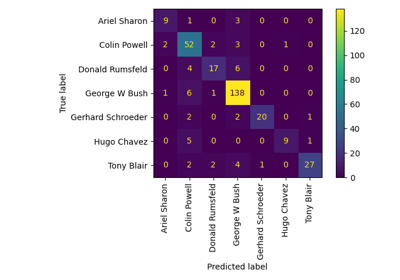fetch_lfw_people#
- sklearn.datasets.fetch_lfw_people(*, data_home=None, funneled=True, resize=0.5, min_faces_per_person=0, color=False, slice_=(slice(70, 195, None), slice(78, 172, None)), download_if_missing=True, return_X_y=False, n_retries=3, delay=1.0)[source]#
Load the Labeled Faces in the Wild (LFW) people dataset (classification).
Download it if necessary.
Classes
5749
Samples total
13233
Dimensionality
5828
Features
real, between 0 and 255
For a usage example of this dataset, see Faces recognition example using eigenfaces and SVMs.
Read more in the User Guide.
- Parameters:
- data_homestr or path-like, default=None
Specify another download and cache folder for the datasets. By default all scikit-learn data is stored in ‘~/scikit_learn_data’ subfolders.
- funneledbool, default=True
Download and use the funneled variant of the dataset.
- resizefloat or None, default=0.5
Ratio used to resize the each face picture. If
None, no resizing is performed.- min_faces_per_personint, default=None
The extracted dataset will only retain pictures of people that have at least
min_faces_per_persondifferent pictures.- colorbool, default=False
Keep the 3 RGB channels instead of averaging them to a single gray level channel. If color is True the shape of the data has one more dimension than the shape with color = False.
- slice_tuple of slice, default=(slice(70, 195), slice(78, 172))
Provide a custom 2D slice (height, width) to extract the ‘interesting’ part of the jpeg files and avoid use statistical correlation from the background.
- download_if_missingbool, default=True
If False, raise an OSError if the data is not locally available instead of trying to download the data from the source site.
- return_X_ybool, default=False
If True, returns
(dataset.data, dataset.target)instead of a Bunch object. See below for more information about thedataset.dataanddataset.targetobject.Added in version 0.20.
- n_retriesint, default=3
Number of retries when HTTP errors are encountered.
Added in version 1.5.
- delayfloat, default=1.0
Number of seconds between retries.
Added in version 1.5.
- Returns:
- dataset
Bunch Dictionary-like object, with the following attributes.
- datanumpy array of shape (13233, 2914)
Each row corresponds to a ravelled face image of original size 62 x 47 pixels. Changing the
slice_or resize parameters will change the shape of the output.- imagesnumpy array of shape (13233, 62, 47)
Each row is a face image corresponding to one of the 5749 people in the dataset. Changing the
slice_or resize parameters will change the shape of the output.- targetnumpy array of shape (13233,)
Labels associated to each face image. Those labels range from 0-5748 and correspond to the person IDs.
- target_namesnumpy array of shape (5749,)
Names of all persons in the dataset. Position in array corresponds to the person ID in the target array.
- DESCRstr
Description of the Labeled Faces in the Wild (LFW) dataset.
- (data, target)tuple if
return_X_yis True A tuple of two ndarray. The first containing a 2D array of shape (n_samples, n_features) with each row representing one sample and each column representing the features. The second ndarray of shape (n_samples,) containing the target samples.
Added in version 0.20.
- dataset
Examples
>>> from sklearn.datasets import fetch_lfw_people >>> lfw_people = fetch_lfw_people() >>> lfw_people.data.shape (13233, 2914) >>> lfw_people.target.shape (13233,) >>> for name in lfw_people.target_names[:5]: ... print(name) AJ Cook AJ Lamas Aaron Eckhart Aaron Guiel Aaron Patterson
Gallery examples#

Faces recognition example using eigenfaces and SVMs
